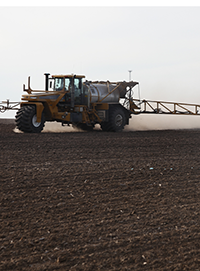 As you’re making herbicide applications this spring, it’s important to get the maximum return on your investment. This means taking steps to ensure they’re both on target and effective. If you apply in the wrong conditions, there’s the potential for off-target movement. Or spray the wrong rates, and you’ll likely see poor results.
As you’re making herbicide applications this spring, it’s important to get the maximum return on your investment. This means taking steps to ensure they’re both on target and effective. If you apply in the wrong conditions, there’s the potential for off-target movement. Or spray the wrong rates, and you’ll likely see poor results.
Here are four tips to help your applications hit the mark this spring.
Work to minimize drift
When spray drift occurs, even in small amounts, it can lead to damage to unintended areas, such as susceptible neighboring crops, and may leave you open to legal action.
Farmers can reduce drift by adopting good management practices, such as setting spray nozzles to deliver larger droplets that are less susceptible to physical drift, and by choosing products that feature low volatility to help limit vapor drift.
Check the weather
In today’s world, most every farmer has weather information available with only the swipe of a finger. Weather apps, such as NOAA High-Def Radar Pro, are great tools to help identify adverse weather conditions before spraying and while the herbicide application is in progress. Check conditions such as wind speed and direction, temperature and humidity — as each of these can significantly impact an application.
Wind speed is a critical factor affecting drift. As wind speeds increase, spray droplets can be carried farther. Before spraying, determine wind speed and direction — especially in relation to nearby sensitive crops or other sites that could be affected.
Temperature and humidity can also affect drift. Both can cause evaporation of spray particles, which reduces the size of the droplets in the air and makes them more susceptible to movement. In general, higher temperatures and lower humidity accelerate evaporation of spray droplets and reduction in their size.
Temperature inversions can also cause small droplets to move out of targeted fields. These occur when calm, low-wind conditions exist. That’s why spraying in wind conditions of zero to 3 mph is not recommended. These conditions can cause herbicide to suspend in this layer of air and move horizontally into neighboring fields.
Prepare your sprayers
There are times when you just can’t remember what you last had in the spray tank. That makes it critical to clean sprayers to remove any leftover residue from previous applications and ensure consistent herbicide applications.
Take these steps to set up sprayers this spring:
- Give sprayers a thorough cleaning. Refer to labels for information on how to correctly clean tanks and parts, including filters, nozzles, tips and joints.
- Scout your fields. Early weed growth and the level of emergence help determine which product is needed and how it should be applied.
- Select the right nozzle. Farmers applying a preemergence herbicide such as SureStart® II herbicide for residual control of broadleaf weeds and grasses should use a nozzle that provides a large spray droplet to obtain even coverage.
Calibrate early and often
Finally, proper calibration helps extract the most value from every corn herbicide application.
It guards not only against applying too little herbicide, which will likely result in poor control results, but also against applying too much, which wastes valuable resources. For instance, if you think you’re applying 15 gallons per acre, but you’re really applying 20, you’re increasing your herbicide costs due to over-application, as well as increasing the risk of crop injury and carryover to next year’s crop.
Dialing in spray equipment at the start of the spray season, combined with regular recalibration during the spray season, helps avoid that scenario.
Taking these easy steps will help ensure you get your corn crop off to a strong start and maximize your yield potential. And, of course, always read herbicide labels and follow instructions.
SureStart II is not registered for sale or use in all states. SureStart II is not available for sale, distribution or use in Nassau and Suffolk counties in the state of New York. Contact your state pesticide regulatory agency to determine if a product is registered for sale or use in your state. Always read and follow label directions.
The More You Grow
Find expert insights on agronomics, crop protection, farm operations and more.